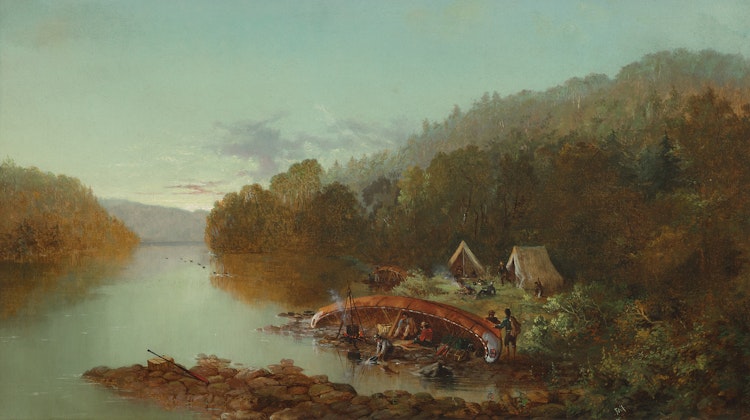Voyageurs Encampment (Camp Scene on the Ottawa) by Frances Anne Hopkins

Frances Anne Hopkins
Voyageurs Encampment (Camp Scene on the Ottawa)
oil on canvas
signed with initials and dated 1867 lower right
15 x 26.25 ins ( 38.1 x 66.7 cms )
Auction Estimate: $70,000.00 - $90,000.00
Price Realized $552,000.00
Sale date: December 1st 2022
Acquired by Lieutenant General Sir James Alexander Lindsay, Montreal/London, circa 1867-1870
By descent to John Coutts and Mary Egidia (née Lindsay) Antrobus, Eaton Hall, Congleton, England, circa 1874
By descent to Robert Henry Antrobus, Eaton Hall, Congleton, England, 1916
By descent to Private Collection
Sotheby’s, New York
Private Collection
“Pop Up Museum”, Canadian Friends of the Israel Museum, 21 August 2018
Frances accompanied Edward on several inspections of Hudson’s Bay Company posts, sketching as she went. Sometime in 1863 the couple took a canoe ride through the Lachine rapids, which she documented in her painting. She then accompanied her husband on at least three longer trips westward: to Lake Superior, to the Ottawa River, and in 1869 a prolonged trip westward to Fort William (present-day Thunder Bay), where she sketched preliminary versions of her first “voyageur” images. These years were a period of transition for the Hudson’s Bay Company, bearing witness to developments in transportation and technology. Canoes were slowly being replaced by steamboats and railways. Hopkins witnessed trade canoe travel in its closing period and made this subject the focus of her art.
Frances Anne Hopkins made several depictions of voyageurs on the water, at camp, or during a portage. She would use the sketches she made en pleir air to inspire larger works on canvas at home. In “Voyageurs Encampment”, the artist presents a scene of setting up camp on a shoreline. A traditional birch bark canoe is turned to its side by the shore, covering two seated men, paddles and luggage. In front of them, a man washes a pan and a cauldron is being heated on a firepit. Behind the canoe, two tents are being pitched, while a man tends to a second firepit. Another canoe is being turned over by two men further along the shore. Surrounding the encampment is a lush forest and a calm body of water, underscoring Canada’s vast amount of nature and wilderness.
By the 1860s, photography was becoming increasingly prominent in Europe, but was still uncommon in the fur trade. Hopkins’ highly detailed paintings therefore also serve a documentary function, as they meticulously record the realities of voyageur life and canoe travel.
Edward Hopkins retired from the Hudson’s Bay Company in 1870 and the family returned to London that same year. Frances Anne Hopkins continued to paint scenes of the Canadian landscape and many of her now famous works were in fact completed after she had returned to London, based on sketches she made while in Canada. She continued to exhibit her paintings at the Royal Academy until her death in 1919.
Possibly the earliest canvas by Frances Hopkins and related to “Camp Scene on the Ottawa”, which was exhibited at the Royal Society of British Artists in London in 1867.
Share this item with your friends
Frances Anne Hopkins
(1838 - 1919)
Born in England, she married Edward Martin Hopkins, a world traveller, in 1858. They travelled to Canada where her husband had a responsible position with the Hudson’s Bay Company. He was required to travel often and she accompanied him on his journeys. Frances Hopkins painted many genre scenes but also a remarkable series of paintings of voyageurs. Many of them were believed done during her trip with the Red River expedition of 1870 headed by Col. G.J. Wolseley. She sketched in oils and watercolours and her Canadian sketch books became the property of the Public Archives of Canada as did her exceptionally fine and detailed Canadian canvases. Most of her work was untitled but she did sign them with her initials F.A.H.
On the Red River expedition she was the only woman. Grave Lee Nute in her well documented and well illustrated article on the artist for ‘The Beaver’ described one of her paintings as follows, “One very appealing picture, which has been reproduced many times, shows a typical bark canoe, beautifully decorated in bow and stern, manned by eight voyageurs, passing the foot of a great shoulder of rock, down which runs a rill in successive waterfalls. A few spruces or balsams can be seen glimpsed above the rock. White water-lilies are attracting the attention of Mrs. Hopkins, for whom a voyageur is picking lilies, while Hopkins looks on, smoking his pipe. The whole conception of the picture is faithful to reality, yet most artistic. Even the reflection of the canoe and its occupants in the clear water of some northern lake is perfection itself.”
The Hopkins returned to England on his retirement sometime after 1870. They lived in London and later at Oxfordshire. Her husband died in 1894 and she died in London in 1918.
Source: "A Dictionary of Canadian Artists, Volume II”, compiled by Colin S. MacDonald, Canadian Paperbacks Publishing Ltd, Ottawa, 1979

